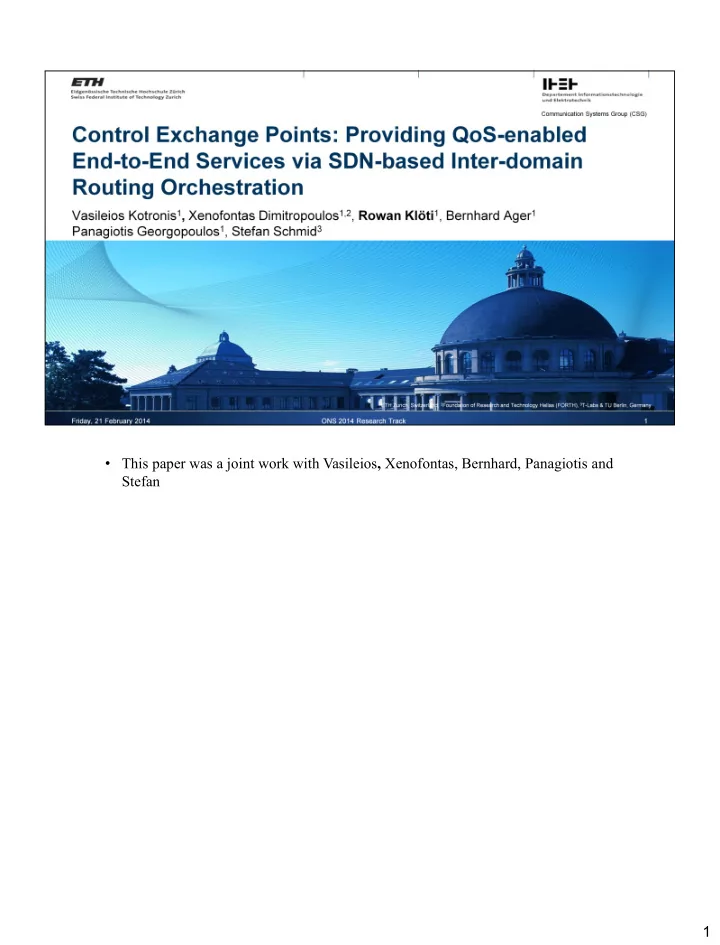

• This paper was a joint work with Vasileios , Xenofontas, Bernhard, Panagiotis and Stefan 1
• Have you ever had a Skype call drop? • Have you ever had poor quality video and lag? 2
• What do you think about playing a piano duet with someone – over the Internet? • Careful coordination is required, so latency must be very low. • This has been implemented – the implementation requires that uncompressed video be sent! 3
• What about having an operation performed from another continent? • Not only do we require uncompressed video, but also high resolution. • Not to mention high availability! 4
• QoS guarantees are possible if a caller and a receiver have the same provider. • The provider has the overview of its link utilisations and solutions exist to allow it to embed its traffic matrix to meet guarantees. 5
• If a caller and receiver have difference providers, then QoS is very difficult with the current Internet. 6
• Between domains, there are no guarantees of bandwidth or latency, or even end- to-end connectivity. • The current inter-domain routing protocol BGP focuses on reachability rather than QoS. • Replacing BGP is far from straightforward. 7
• We propose Control Exchange Points • Control Exchange Points provide application-specific SDN-based peering. • Each Control Exchange Point consists one logically centralised controller and many data plane anchors which are operated by the controller • Data plane anchors are situated on the edge of ISP networks. • The solution allows for multiple competing CXPs as well as the coexistence with existing inter-domain routing. • Some of the concepts of this paper have been discussed in prior work. 8
• ISP participating in the scheme announce pathlets to the controller. • The pathlets connect between data plane anchors and are annotated with performance guarantees. • The ISPs are paid for the use of the pathlets. 9
• A user who wants an end-to-end path with QoS guarantees sends a request with the endpoints and the required guarantees to the controller. 10
• The controller computes several valid paths using the offered pathlets and selects one. • The remaining paths may be kept as a backup. 11
• After establishing the path, the controller continues to monitor the performance of the path via instrumentation at the data plane anchor and possibly at the endpoints. 12
• The controller can detect violations of QoS guarantees, or even a completely failed link. 13
• When QoS guarantees are violated, the controller performs a dynamic rerouting using an alternative path. • The caller and receiver need not notice the change of route. 14
• The question remains: where to deploy these data plane anchors? • We need a central location with good path diversity and high bandwidth and availability, but without depending on a single provider. 15
• We propose to use Internet Exchange Points for data plane anchors. • They have hundreds of participants (DE-CIX has over 600). • They exchange terabits of traffic every second but yet are not controlled by individual ISPs. • But what about path diversity and coverage? 16
• We investigated path diversity and coverage. • The plot on the left shows how many IP addresses we can service from a given number of IXPs. • The green curve is for providers attached directly to IXPs. • The blue curve is for providers attached to IXPs and their customers over one hop. • The red line is total number of announced IPv4 addresses. • We can service a large portion of the Internet address space from just a modest number of IXPs and, if we allow for a single customer-provider hop, virtually the entire Internet. • On the right you can see a table showing just how many members the largest IXPs have in common. • With dozens and even hundreds of members connecting between the IXP pairs, the path diversity available is large. 17
• We are currently working on the simulation of path embedding, in order to refine the algorithm and perform sensitivity analysis. • We are investigating deployment scenarios. • We will be developing an emulation of the working system, in order to test APIs, as well as considering the Software Defined Exchange concept introduced by Nick Feamster et al. 18
• In this talk we have proposed a solution for interdomain QoS. • We presented the concept of Control Exchange Points, which employ SDN to offer dynamically routed end-to-end paths with performance and connectivity guarantees. 19
Recommend
More recommend